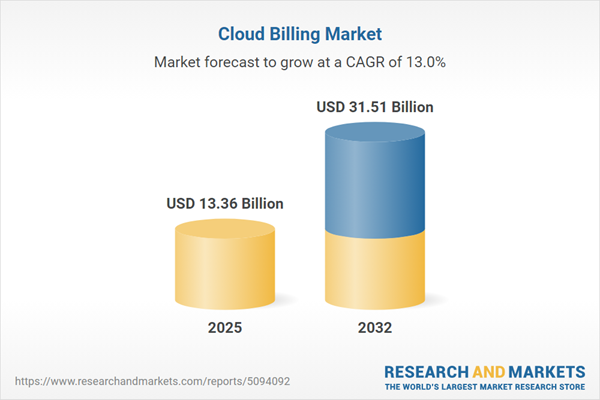Speak directly to the analyst to clarify any post sales queries you may have.
The cloud billing market is rapidly evolving as enterprises seek intelligent cost management tools to drive operational transparency, efficiency, and innovation in increasingly complex digital infrastructures. This report delivers a comprehensive analysis tailored to executives navigating the shifting dynamics of cloud solutions across diverse industries and geographies.
Market Snapshot: Cloud Billing Market Size & Growth
The cloud billing market grew from USD 11.84 billion in 2024 to USD 13.36 billion in 2025. It is expected to continue growing at a CAGR of 13%, reaching USD 31.51 billion by 2032. This expansion reflects heightened demand for transparent, agile financial management as organizations expand their use of hybrid and multi-cloud solutions, adopt consumption-based IT models, and prioritize cost accountability throughout their operations.
Scope & Market Segmentation
- Service Type: Container as a Service (Docker, Kubernetes), Function as a Service, Infrastructure as a Service (Compute, Networking, Storage), Platform as a Service (AI Platform, Analytics, Database), Software as a Service (Collaboration, Customer Relationship Management, Enterprise Resource Planning)
- Billing Method: Postpaid, Prepaid
- Industry Vertical: Banks, Financial Services, Insurance, Healthcare, IT and Telecom, Manufacturing, Retail
- Organization Size: Large Enterprise, Small and Medium Enterprise
- Geographic Regions: Americas (North America: United States, Canada, Mexico; Latin America: Brazil, Argentina, Chile, Colombia, Peru), Europe, Middle East, and Africa (Europe: United Kingdom, Germany, France, Russia, Italy, Spain, Netherlands, Sweden, Poland, Switzerland; Middle East: United Arab Emirates, Saudi Arabia, Qatar, Turkey, Israel; Africa: South Africa, Nigeria, Egypt, Kenya), Asia-Pacific (China, India, Japan, Australia, South Korea, Indonesia, Thailand, Malaysia, Singapore, Taiwan)
- Key Market Players: Zuora, SAP SE, Oracle Corporation, Amdocs Limited, CSG International, Telefonaktiebolaget LM Ericsson, Netcracker Technology Corporation, Huawei Technologies, Comarch, IBM
Key Takeaways for Senior Decision-Makers
- Cloud billing has advanced from basic cost allocation to a strategic role, enabling enterprises to align financial governance with agile operations and technology innovation.
- Modern cloud billing platforms offer granular tracking and near real-time insights, empowering proactive budget control and driving collaboration between finance and engineering teams.
- Comprehensive billing systems now incorporate ESG reporting, compliance management, and resource optimization metrics to support broader corporate objectives and stakeholder expectations.
- Segment-specific adoption patterns reveal that industries such as banking, healthcare, and retail require billing solutions tailored for regulatory compliance, scalability, and efficiency.
- Large enterprises optimize costs through custom pricing and deep financial integration, while SMBs leverage user-friendly dashboards and managed subscriptions for predictable spend.
- Regional market maturity, regulatory frameworks, and digital transformation agendas shape the way organizations approach billing transparency and consumption optimization globally.
Tariff Impact: Navigating Cost Dynamics and Supply Chains in 2025
The introduction of United States tariffs on imported hardware and service elements in 2025 reshapes cloud billing structures. Increased input costs for providers drive pricing adjustments, potential surcharges, and modifications to service tiers. Enterprises relying on compute and storage must reevaluate deployment strategies and budget models. These tariffs also expedite supply chain diversification and encourage partnerships with domestic technology manufacturers, leading to localized infrastructure strategies for both providers and clients.
Methodology & Data Sources
This analysis integrates primary research from industry interviews with cloud, finance, and procurement executives, combined with secondary data from public reports and sector publications. Quantitative insights from anonymized billing datasets support segmentation and regional findings. Triangulation ensures reliability and objectivity in every insight.
The Cloud Billing Market: Why This Report Matters
- Gain clarity on key market segments, technology adoption patterns, and provider strategies driving change in the cloud billing space.
- Understand the financial and operational implications of recent regulatory actions, such as tariffs and ESG mandates, on both global and regional billing best practices.
- Equip your organization to negotiate effectively, optimize spend, and foster cross-functional collaboration for ongoing innovation and business agility.
Conclusion
This research highlights the pivotal role of cloud billing in enabling efficient digital transformation and cost management. By leveraging actionable insights and market trends, enterprises can drive sustainable growth and stay competitive in a quickly changing landscape.
Additional Product Information:
- Purchase of this report includes 1 year online access with quarterly updates.
- This report can be updated on request. Please contact our Customer Experience team using the Ask a Question widget on our website.
Table of Contents
3. Executive Summary
4. Market Overview
7. Cumulative Impact of Artificial Intelligence 2025
Companies Mentioned
The companies profiled in this Cloud Billing market report include:- Zuora, Inc.
- SAP SE
- Oracle Corporation
- Amdocs Limited
- CSG International, Inc.
- Telefonaktiebolaget LM Ericsson
- Netcracker Technology Corporation
- Huawei Technologies Co., Ltd.
- Comarch S.A.
- International Business Machines Corporation
Table Information
| Report Attribute | Details |
|---|---|
| No. of Pages | 184 |
| Published | October 2025 |
| Forecast Period | 2025 - 2032 |
| Estimated Market Value ( USD | $ 13.36 Billion |
| Forecasted Market Value ( USD | $ 31.51 Billion |
| Compound Annual Growth Rate | 13.0% |
| Regions Covered | Global |
| No. of Companies Mentioned | 11 |









